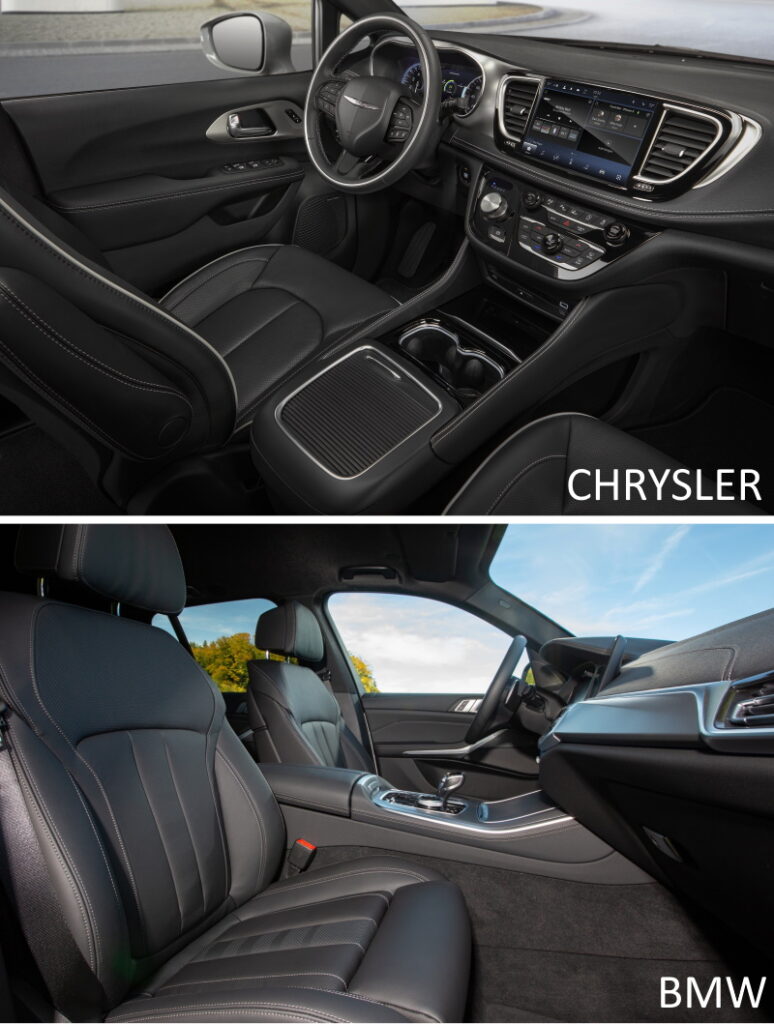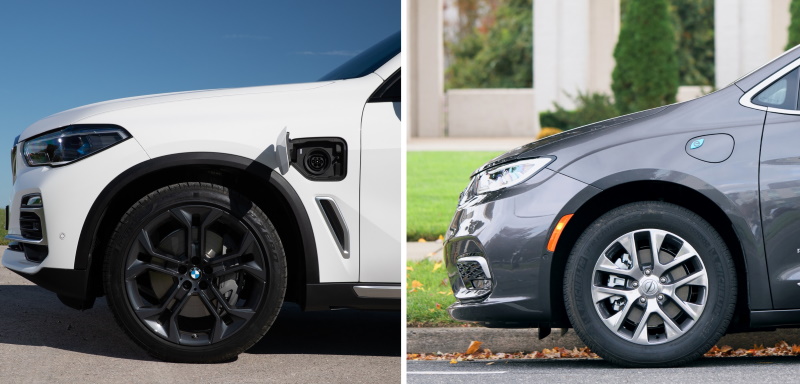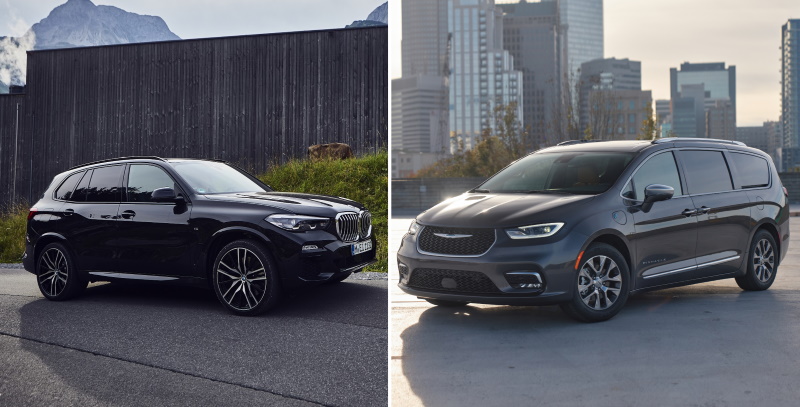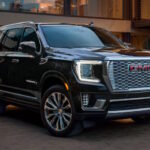PHEV. These plug-in hybrid vehicles make it easier to not worry about range anxiety compared to an all-electric vehicle. The benefits of these are the larger increases in mpg as well as a fun little boost in acceleration. You can throw a dart at manufacturers and, for the most part, you’ll find at least one. PHEVs are quite interesting, but is the type of vehicle you should look at? We are going to look at two very different vehicles that are PHEVs and see if you should even look at them in this form.
BMW vs. Chrysler, SUV vs. minivan, and a $30,000 price gap. You’re probably wondering “why would you compare these two”? Yes, they are quite different, yet the similarities are more abundant than you’d think. The obvious comparison is the PHEV component along with how the vehicles charge, acceleration, regenerative braking, and of course, fuel economy. Ready for the twist? Only one will be recommended as a hybrid while the other is recommended as a regular gasoline model. With that, let’s first take a look at the BMW X5.
Regular BMW X5s are quite handsome and do have the now traditional BMW massive grille. As with the Pacifica hybrid, the charging parts are near the front of the car on the driver’s side. It’s a luxury vehicle with air suspension that really helps with entry and exiting. There’s a neat split-opening tailgate that’s fully automatic and helps with loading multiple grocery bags. The charging cord is under the trunk floor which gives extra space if you decide to use it. Colors were gray for the exterior and a lovely brown interior.
The interior is also pure BMW which means the quality is top-notch. This X5 had a glass control option that made the shifter and iDrive wheel clear stylized glass. It’s a classy option that’s totally unnecessary. Speaking of the iDrive, it’s a fantastic infotainment system that takes full advantage of being a touchscreen and using the iDrive swivel wheel. Climate control is decent to use, but it has nothing to brag about. There was a heated steering wheel and heated seats, but for $81,000, there weren’t any massaging seats and ventilated seats since those were options this tester didn’t have. I really didn’t have many complaints about the interior.
Moving to the complicated engine which I’ll make easy: it’s a straight-six engine with electric batteries that make a combined 389-horsepower and 443 lb-ft. This has an eight-speed and gets the all-wheel-drive goes from 0-60 MPH in 4.7 seconds but there’s no way I could even get close. That’s because the charging for the X5 is long. Really long. Now, I did try a level 2 charger along with charging at my house but thanks to an unusual week, I was only able to get 12 miles of range. It charged at home at 1% per hour! Thankfully, the X5 has multiple engine modes include EV, hybrid, and sport.

The engine makes plenty of power and the suspension soaked up bumps, as you would expect for a luxury SUV. You would also assume that advanced safety features would work without fault but it never worked for me. NOTE: this was not BMW’s fault. Due to an error with the license plate, a specific radar was blocked. I’ve driven a regular BMW 5-series with the safety features and I really enjoyed it. I’m not blaming BMW for this but it would have been nice to use for the week I had it.
From the BMW to the Chrysler, we will look at…a minivan! This is one of the best-looking minivans and uses some subtle hints that it’s a PHEV. Its party trick: kick under the tailgate and the sliding doors. All of these are power-operated and all can be open with a swift kick in the underside. The color was steel metallic while the interior had Nappa-leather brown and black. Even though this was more of a refresh, it still looks quite good. If you don’t like minivans, you’ll think it’s the wrong choice compared to an SUV. I disagree.
I thought the interior was laid out with some oddities. Entry for me was difficult because I basically flopped onto the seats and only had the thin armrest to use. The Uconnect infotainment system works quite well but shouldn’t be compared to the BMW’s iDrive. This is a van and is laid out exactly like a van. It’s functional, but the middle row chairs have to manually be taken out since they’re upgraded. Also, the placement of the cupholders for the second row just doesn’t make sense since it has to slide from the center console and you can’t put anything in the front door pockets. Thankfully, this had heated and ventilated seats as well as a heated steering wheel.
In terms of driving, I was able to have a full charge since it took a quarter of the time the X5 would have taken, so I took full advantage of the electric driving. It’s also comfortable like the X5 and can switch seamlessly between hybrid and EV, but there are two catches. First, the stats. It uses a V6 and combines the electric motors to create 260 horsepower and around 260 lb-ft. This is front-wheel drive only and takes 8.2 seconds from 0-60 MPH, but if it is below 40 MPH, it feels quite nippy. The second catch: it uses an eCVT and when the V6 turns on, it drones. There are also no driving modes so you can’t decide you want hybrid or EV modes. Chrysler, please let people have these.

Back to the PHEV complexities, both PHEVs take some time to charge, but the X5 takes 22 hours on a regular home charger for 100%. Since the Pacifica only took 12 hours, I could actually have it at full charge. I know I could use a rapid charger, but I had no patience to wait 4-6 hours at an upgraded charger. Of course, you can get an upgraded charger which costs between $500-$1,000. If you own a PHEV, I would recommend getting this upgrader charger. You can still use a regular plug but they just take too long.
This brings me to the question: which one of these should be bought as a PHEV, and which one should be bought as a regular gas engine? This was quite simple. The BMW X5 works better than a regular gas engine. It’s already a luxurious vehicle, but as a BMW, be prepared to add $15-20,000 to the $67,000 base price. Chrysler made a great minivan that just so happens to be a PHEV. $50,000 gets you the second-highest Limited model and I’d just stick with that. What’s great is that the X5 and Pacifica are both terrific vehicles. I’m going to skip my stats section and just say: the Pacifica gained an 8.7/10 while the X5 gained an 8.2/10. Even though EVs are the future (and present), PHEVs are a great transition point to full electricity and both the BMW xDrive45e and Chrysler Pacifica are pleasant vehicles. Just make sure to have a full charge.



















